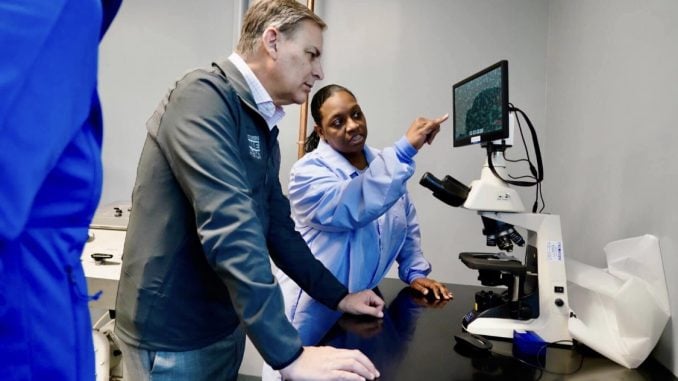
MEBANE — Jay Timmons, president of the National Association of Manufacturers, America’s largest trade association for manufacturing, made stops in North Carolina during their fifth annual “State of Manufacturing” tour. This year’s tour has stops in North Carolina, Colorado, Texas, Ohio, Iowa, Minnesota, California and Arizona after a year which NAM calls its “best year in more than two decades for manufacturing job creation.”
Timmons and his team visited ABB in Mebane and Johnston Community College’s Workforce Development Center for a roundtable with the North Carolina Chamber of Commerce.
While touring ABB, which creates robotics used in manufacturing, NAM leaders, along with local students and employees, discussed what is attractive about these jobs. Some students were surprised to hear that the workers had been in the jobs for over 30 years and had stayed because the jobs were stable, well-paying and exciting. The workers told visitors that they saw the technology involved as something that will save their jobs and keep them competitive rather than something that is a threat to their jobs.
“It’s a false narrative that technology is costing jobs,” Timmons told North State Journal. “It’s actually creating employment opportunities all across the country in manufacturing. Of all the plant tours I’ve done, I’ve never seen some of the things I saw at ABB. They are doing some really cool things.”
A major focus of the tour is to spread the word to young people that if they are looking for a great career path, they should look towards manufacturing.
Carolyn Lee, executive director for the Manufacturing Institute, NAM’s education workforce partner, joined Timmons on the North Carolina visit. Lee runs multiple programs in the institute with a mission of making people aware of the more than 428,000 jobs that are open in manufacturing. The institute says its research has found that this gap will grow to 2.4 million jobs in the next 10 years. To avoid the growth of unfilled positions, more skilled workers need to be drawn to the industry.
Part of what will draw a lot of “very brilliant people,” Timmons said, is that they can begin well-paying careers in manufacturing straight out of high school or with a quick community college training program and not have to go deeply in debt for a college degree with no guaranteed job on the other side.
“So, part of this tour’s purpose is for recruiting,” Timmons said. “We want people to know about these jobs and that they are higher paying than other sectors. In fact, in North Carolina, manufacturing workers average about $69,000, and that’s compared to only $43,000 in all areas of the economy.”
In North Carolina, Timmons said NAM has seen an especially high demand for software developers, first-line supervisors and engineering technicians from his member companies.
“North Carolina is a very strong state when it comes to manufacturing, and a lot of that is because of the policies that have been put in place over the years by various governors and legislatures,” Timmons told NSJ.
He also credits positive national trends to government policy and has been “really impressed with what the administration has been able to get done,” regarding President Trump’s campaign promises on bringing manufacturing back to the United States and renegotiating trade.
Areas he said domestic manufacturers have especially benefited from include intellectual property protection and redoing trade deals like the US-Mexico-Canada Agreement and with regards to China.
“When it comes to China, China cheats,” Timmons said. “United States manufacturers have spent the last 25 years trying to work around their uncompetitive activities, like counterfeiting. Frankly, it’s been a rough ride for a lot of manufacturers. We’re never a fan of tariffs, because tariffs drive up the cost of doing business, but this is the first president in decades to get China’s attention.
“Tax reform and regulatory certainty have really supercharged manufacturing in the United States,” Timmons said.
Among NAM’s 14,000 members, 90 percent report an optimistic look on the future because of removing these hurdles. Next they plan to address some of the infrastructure concerns that will help get their products to market.
Internationally, he said they will focus on opening up more markets because 95 percent of the world’s consumer-base is outside the borders of the United States.
The National Association of Manufacturers, founded in Cincinnati in 1895, is based in Washington, D.C.
